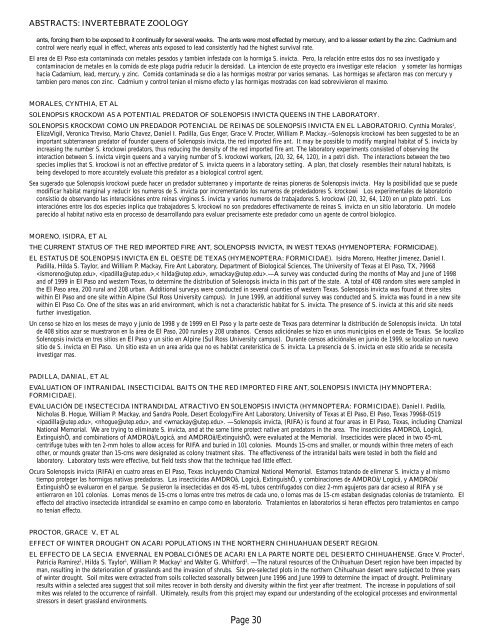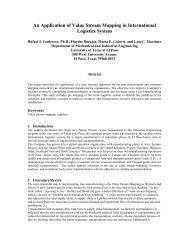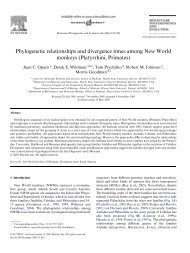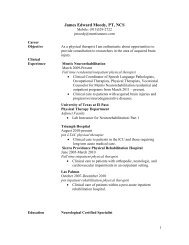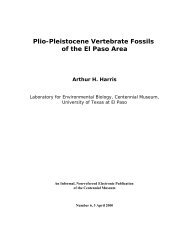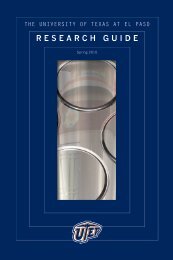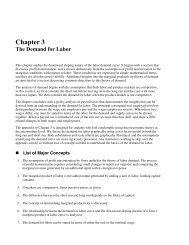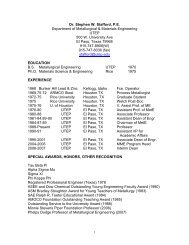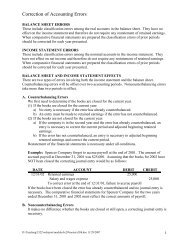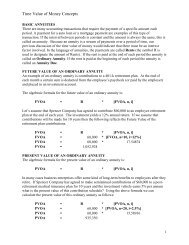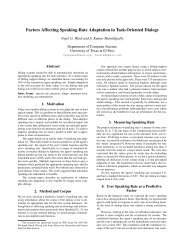Sym - Abstracts - University of Texas at El Paso
Sym - Abstracts - University of Texas at El Paso
Sym - Abstracts - University of Texas at El Paso
You also want an ePaper? Increase the reach of your titles
YUMPU automatically turns print PDFs into web optimized ePapers that Google loves.
ABSTRACTS: INVERTEBRATE ZOOLOGY<br />
ants, forcing them to be exposed to it continually for several weeks. The ants were most effected by mercury, and to a lesser extent by the zinc. Cadmium and<br />
control were nearly equal in effect, whereas ants exposed to lead consistently had the highest survival r<strong>at</strong>e.<br />
<strong>El</strong> area de <strong>El</strong> <strong>Paso</strong> esta contaminada con metales pesados y tambien infestada con la hormiga S. invicta. Pero, la relación entre estos dos no sea investigado y<br />
contaminacion de metales en la comida de este plaga pudria reducir la densidad. La intencion de este proyecto era investigar este relacion y someter las hormigas<br />
hacia Cadamium, lead, mercury, y zinc. Comida contaminada se dio a las hormigas mostrar por varios semanas. Las hormigas se afectaron mas con mercury y<br />
tambien pero menos con zinc. Cadmium y control tenian el mismo efecto y las hormigas mostradas con lead sobrevivieron el maximo.<br />
MORALES, CYNTHIA, ET AL<br />
SOLENOPSIS KROCKOWI AS A POTENTIAL PREDATOR OF SOLENOPSIS INVICTA QUEENS IN THE LABORATORY.<br />
SOLENOPSIS KROCKOWI COMO UN PREDADOR POTENCIAL DE REINAS DE SOLENOPSIS INVICTA EN EL LABORATORIO. Cynthia Morales 1 ,<br />
<strong>El</strong>izaVigil, Veronica Treviso, Mario Chavez, Daniel I. Padilla, Gus Enger, Grace V. Procter, William P. Mackay.--Solenopsis krockowi has been suggested to be an<br />
important subterranean pred<strong>at</strong>or <strong>of</strong> founder queens <strong>of</strong> Solenopsis invicta, the red imported fire ant. It may be possible to modify marginal habit<strong>at</strong> <strong>of</strong> S. invicta by<br />
increasing the number S. krockowi pred<strong>at</strong>ors, thus reducing the density <strong>of</strong> the red imported fire ant. The labor<strong>at</strong>ory experiments consisted <strong>of</strong> observing the<br />
interaction between S. invicta virgin queens and a varying number <strong>of</strong> S. krockowi workers, (20, 32, 64, 120), in a petri dish. The interactions between the two<br />
species implies th<strong>at</strong> S. krockowi is not an effective pred<strong>at</strong>or <strong>of</strong> S. invicta queens in a labor<strong>at</strong>ory setting. A plan, th<strong>at</strong> closely resembles their n<strong>at</strong>ural habit<strong>at</strong>s, is<br />
being developed to more accur<strong>at</strong>ely evalu<strong>at</strong>e this pred<strong>at</strong>or as a biological control agent.<br />
Sea sugerado que Solenopsis krockowi puede hacer un predador subterraneo y importante de reinas pioneras de Solenopsis invicta. Hay la posibilidad que se puede<br />
modificar habit<strong>at</strong> marginal y reducir los numeros de S. invicta por incrementando los numeros de prededadores S. krockowi Los experimentales de labor<strong>at</strong>orio<br />
consistio de observando las interacisiónes entre reinas virgines S. invicta y varios numeros de trabajadores S. krockowi (20, 32, 64, 120) en un pl<strong>at</strong>o petri. Los<br />
interaciónes entre los dos especies inplica que trabajadores S. krockowi no son predadores effectivamente de reinas S. invicta en un sitio labor<strong>at</strong>orio. Un modelo<br />
parecido al habit<strong>at</strong> n<strong>at</strong>ivo esta en processo de desarrollando para evaluar precisamente este predador como un agente de control biologico.<br />
MORENO, ISIDRA, ET AL<br />
THE CURRENT STATUS OF THE RED IMPORTED FIRE ANT, SOLENOPSIS INVICTA, IN WEST TEXAS (HYMENOPTERA: FORMICIDAE).<br />
EL ESTATUS DE SOLENOPSIS INVICTA EN EL OESTE DE TEXAS (HYMENOPTERA: FORMICIDAE). Isidra Moreno, He<strong>at</strong>her Jimenez, Daniel I.<br />
Padilla, Hilda S. Taylor, and William P. Mackay, Fire Ant Labor<strong>at</strong>ory, Department <strong>of</strong> Biological Sciences, The <strong>University</strong> <strong>of</strong> <strong>Texas</strong> <strong>at</strong> <strong>El</strong> <strong>Paso</strong>, TX, 79968<br />
, ,< hilda@utep.edu>, wmackay@utep.edu>.—A survey was conducted during the months <strong>of</strong> May and June <strong>of</strong> 1998<br />
and <strong>of</strong> 1999 in <strong>El</strong> <strong>Paso</strong> and western <strong>Texas</strong>, to determine the distribution <strong>of</strong> Solenopsis invicta in this part <strong>of</strong> the st<strong>at</strong>e. A total <strong>of</strong> 408 random sites were sampled in<br />
the <strong>El</strong> <strong>Paso</strong> area, 200 rural and 208 urban. Additional surveys were conducted in several counties <strong>of</strong> western <strong>Texas</strong>. Solenopsis invicta was found <strong>at</strong> three sites<br />
within <strong>El</strong> <strong>Paso</strong> and one site within Alpine (Sul Ross <strong>University</strong> campus). In June 1999, an additional survey was conducted and S. invicta was found in a new site<br />
within <strong>El</strong> <strong>Paso</strong> Co. One <strong>of</strong> the sites was an arid environment, which is not a characteristic habit<strong>at</strong> for S. invicta. The presence <strong>of</strong> S. invicta <strong>at</strong> this arid site needs<br />
further investig<strong>at</strong>ion.<br />
Un censo se hizo en los meses de mayo y junio de 1998 y de 1999 en <strong>El</strong> <strong>Paso</strong> y la parte oeste de <strong>Texas</strong> para determinar la distribución de Solenopsis invicta. Un total<br />
de 408 sitios azar se muestraron en la área de <strong>El</strong> <strong>Paso</strong>, 200 rurales y 208 urabanos. Censos adiciónales se hizo en unos municipios en el oeste de <strong>Texas</strong>. Se localizo<br />
Solenopsis invicta en tres sitios en <strong>El</strong> <strong>Paso</strong> y un sitio en Alpine (Sul Ross <strong>University</strong> campus). Durante censos adiciónales en junio de 1999, se localizo un nuevo<br />
sitio de S. invicta en <strong>El</strong> <strong>Paso</strong>. Un sitio esta en un area arida que no es habit<strong>at</strong> careteristica de S. invicta. La presencia de S. invicta en este sitio arida se necesita<br />
investigar mas.<br />
PADILLA, DANIAL, ET AL<br />
EVALUATION OF INTRANIDAL INSECTICIDAL BAITS ON THE RED IMPORTED FIRE ANT, SOLENOPSIS INVICTA (HYMNOPTERA:<br />
FORMICIDAE).<br />
EVALUACIÓN DE INSECTECIDA INTRANDIDAL ATRACTIVO EN SOLENOPSIS INVICTA (HYMNOPTERA: FORMICIDAE). Daniel I. Padilla,<br />
Nicholas B. Hogue, William P. Mackay, and Sandra Poole, Desert Ecology/Fire Ant Labor<strong>at</strong>ory, <strong>University</strong> <strong>of</strong> <strong>Texas</strong> <strong>at</strong> <strong>El</strong> <strong>Paso</strong>, <strong>El</strong> <strong>Paso</strong>, <strong>Texas</strong> 79968-0519<br />
, , and . —Solenopsis invicta, (RIFA) is found <strong>at</strong> four areas in <strong>El</strong> <strong>Paso</strong>, <strong>Texas</strong>, including Chamizal<br />
N<strong>at</strong>ional Memorial. We are trying to elimin<strong>at</strong>e S. invicta, and <strong>at</strong> the same time protect n<strong>at</strong>ive ant pred<strong>at</strong>ors in the area. The insecticides AMDROâ, Logicâ,<br />
ExtinguishÔ, and combin<strong>at</strong>ions <strong>of</strong> AMDROâ/Logicâ, and AMDROâ/ExtinguishÔ, were evalu<strong>at</strong>ed <strong>at</strong> the Memorial. Insecticides were placed in two 45-mL<br />
centrifuge tubes with ten 2-mm holes to allow access for RIFA and buried in 101 colonies. Mounds 15-cms and smaller, or mounds within three meters <strong>of</strong> each<br />
other, or mounds gre<strong>at</strong>er than 15-cms were design<strong>at</strong>ed as colony tre<strong>at</strong>ment sites. The effectiveness <strong>of</strong> the intranidal baits were tested in both the field and<br />
labor<strong>at</strong>ory. Labor<strong>at</strong>ory tests were effective, but field tests show th<strong>at</strong> the technique had little effect.<br />
Ocura Solenopsis invicta (RIFA) en cu<strong>at</strong>ro areas en <strong>El</strong> <strong>Paso</strong>, <strong>Texas</strong> incluyendo Chamizal N<strong>at</strong>ional Memorial. Estamos tr<strong>at</strong>ando de elimenar S. invicta y al mismo<br />
tiempo proteger las hormigas n<strong>at</strong>ivas predadoras. Las insecticidas AMDROâ, Logicâ, ExtinguishÔ, y combinaciones de AMDROâ/ Logicâ, y AMDROâ/<br />
ExtinguishÔ se evaluaron en el parque. Se pusieron la insectecidas en dos 45-mL tubos centrifugados con diez 2-mm agujeros para dar acseso al RIFA y se<br />
entierraron en 101 colonias. Lomas menos de 15-cms o lomas entre tres metros de cada uno, o lomas mas de 15-cm estaban designadas colonias de tr<strong>at</strong>amiento. <strong>El</strong><br />
effecto del <strong>at</strong>ractivo insectecida intrandidal se examino en campo como en labor<strong>at</strong>orio. Tr<strong>at</strong>amientos en labor<strong>at</strong>orios si heran effectos pero tr<strong>at</strong>amientos en campo<br />
no tenian effecto.<br />
PROCTOR, GRACE V., ET AL<br />
EFFECT OF WINTER DROUGHT ON ACARI POPULATIONS IN THE NORTHERN CHIHUAHUAN DESERT REGION.<br />
EL EFFECTO DE LA SECIA ENVERNAL EN POBALCIÓNES DE ACARI EN LA PARTE NORTE DEL DESIERTO CHIHUAHENSE. Grace V. Procter 1 ,<br />
P<strong>at</strong>ricia Ramirez 1 , Hilda S. Taylor 1 , William P. Mackay 1 and Walter G. Whitford 2 . —The n<strong>at</strong>ural resources <strong>of</strong> the Chihuahuan Desert region have been impacted by<br />
man, resulting in the deterior<strong>at</strong>ion <strong>of</strong> grasslands and the invasion <strong>of</strong> shrubs. Six pre-selected plots in the northern Chihuahuan desert were subjected to three years<br />
<strong>of</strong> winter drought. Soil mites were extracted from soils collected seasonally between June 1996 and June 1999 to determine the impact <strong>of</strong> drought. Preliminary<br />
results within a selected area suggest th<strong>at</strong> soil mites recover in both density and diversity within the first year after tre<strong>at</strong>ment. The increase in popul<strong>at</strong>ions <strong>of</strong> soil<br />
mites was rel<strong>at</strong>ed to the occurrence <strong>of</strong> rainfall. Ultim<strong>at</strong>ely, results from this project may expand our understanding <strong>of</strong> the ecological processes and environmental<br />
stressors in desert grassland environments.<br />
Page 30


